In the news
Government prize for translation 2012
14 September 2012 | In the news

Vladimír Piskoř. Photo: Charlotta Boucht
The Finnish Government Prize for the Translation of Finnish Literature of 2012 – worth €15,000 – was awarded to the Czech translator Vladimír Piskoř.
Piskoř (born 1960), graduated from the Charles University of Prague in 1984, majoring in Finnish. Since the early 1990s he has translated almost 30 titles, most by contemporary authors, including Kristina Carlson, Kari Hotakainen, Leena Krohn, Rosa Liksom, Asko Sahlberg, Juha Seppälä, Petri Tamminen and Maria Peura.
‘I personally am fond of the novels by Kari Hotakainen: I sometimes play with the idea of becoming a writer myself, and I find his style and themes particularly interesting. Kristina Carlson’s latest novel Herra Darwinin puutarhuri (‘Mr Darwin’s gardener’, 2010) is a truly inspiring work both as a reader and a translator,’ he says.
Piskoř is currently working on Kari Hotakainen’s novel Jumalan sana (‘The word of God’) and Leena Lander’s historical novel Käsky (‘Command’). In 2006 he was awarded the Czech translators’ special prize for the novel Höyhen (‘Feather’) by Asko Sahlberg.
Vladimír Piskoř received his award in Helsinki on 10 September from State Secretary Jarmo Lindén; he thanked Piskoř for the work he has done for the last twenty years, particularly in the field of contemporary Finnish fiction.
The prize has been awarded – now for the 38th time – by the Ministry of Education and Culture since 1975 on the basis of a recommendation by FILI – Finnish Literature Exchange.
Comics come to Helsinki
7 September 2012 | In the news
 Comics are the ‘ninth art’, according to the organisers of the 27th Helsinki Comics Festival, which runs from 7 to 9 September.
Comics are the ‘ninth art’, according to the organisers of the 27th Helsinki Comics Festival, which runs from 7 to 9 September.
This time, the special theme examines comics in relation to visual arts, and the main venue of the Festival is the Kiasma Museum of Contemporary Art in Helsinki. An exhibition entitled Eyeballing! and a concert series where comics meet music will take place there – artists improvise drawings inspired by live music.
Belgium is the country of focus; in the homeland of the classic Tintin the tradition and the experimental forms of comics live side by side. Among the guest artists will be Benôit Sokal and François Schuiten, Gert Meesters and Herr Seele from Belgium, Émile Bravo from France and Arne Bellstorf from Germany. Tommi Musturi and Amanda Vähämäki are the Finnish guests.
The ninth art? In Greek mythology, the Muses are nine goddesses personifying the fields of the arts. So nowadays Polymnia, Clio, Melpomene, Urania, Euterpe, Terpsichore, Calliope, Erato and Thalia inspire, respectively, painting (including drawing and photography), sculpture, theatre, architecture, music, dance, literature, cinema (as well as television & video) – and comics.
Thalia is ‘the amused muse’: in most languages the term for comics is a variant of ‘comic story’ or ‘amusing art’ – but the Finns call comics sarjakuva (serial pictures), which is what they mostly are.
A library visit
17 August 2012 | In the news

Please come in: National Library of Finland. Photo: Kallerna/Wikimedia
Take a tour: browsing the online bulletin of the Finnish National Library, you’ll find a link (for iPad or other devices) which takes you inside the handsome main building, next to the Cathedral in the heart of Helsinki.
The library building, from 1845, was designed by the most important architect of the city, C.L. Engel.
The latest issue of the library bulletin includes articles on research, conservation and digitisation of the library collections as well as news and pictures.
Funny in favour (again)
8 June 2012 | In the news
The May list of best-selling Finnish fiction titles, compiled by the Finnish Booksellers’ Association, still features two novels about a grumpy old man (see In the news) by Tuomas Kyrö (a grumpy young man): Mielensäpahoittaja ja ruskeakastike (‘Taking offence and the brown sauce’) and Mielensäpahoittaja (‘Taking offence’, both WSOY) were number one and two.
Number three was a work by a classic humorist: Veikko Huovinen (1927–2009) was a highly original and versatile writer whose career lasted almost for 60 years. A selection of his short prose from 1950 to 2001, previously unpublished or published in various magazines, appeared in May: Luonnonkierto (‘Nature’s cycle’, Siltala) immediately shot up to the third place on the month’s list. (You’ll find one of these texts coming up next on this site!)
As summer was approaching at last, the non-fiction list featured several books on birds, grilling and cooking – as well as aphorisms and other food for thought, traditionally bought for young people graduating from school.
What Finland read in April…
18 May 2012 | In the news
…was Tuomas Kyrö mostly, it seems: at the top of the April list of best-selling fiction titles in Finland, compiled by the Finnish Booksellers’ Association, was his novel Mielensäpahoittaja ja ruskeakastike (‘Taking offense: the brown sauce’, WSOY).
In March, Kyrö (born 1974) already featured twice on the list: his first novel about a 80-something man, Mielensäpahoittaja (‘Taking offense’, WSOY, 2010) was number two, and the newly-published sequel, Mielensäpahoittaja ja ruskeakastike had shot up to sixth place. In April they changed places – with the audio book version of the brown sauce book at number five.
This mielensäpahoittaja, ‘he who takes offence’, lives in the countryside and opposes most of what a contemporary lifestyle has to offer. Finns are evidently highly amused by the opinions of this obstinate, grumpy old man. But the popularity of Kyrö’s literary creation may also be boosted by the fact that he currently takes part in a television talk show every week, entertaining the audience and his fellow guests with his often acerbic remarks.
A crime novel by Seppo Jokinen, Hervantalainen (‘The person from Hervanta’, Crime Time), occupied third place, Tarhapäivä (‘Kindergarten day’, Otava) by Eve Hietamies fourth.
On the non-fiction list Solzhenitsyn’s The Gulag Archipelago, republished by Silberfeldt in April, was already in third place; we published a news piece about it on 25 April.
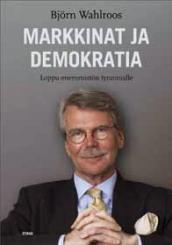 The non-fiction list was topped by a new, controversial book by banker – and one of the richest men in Finland – Björn Wahlroos, Markkinat ja demokratia. Loppu enemmistön tyrannialle (‘Market and democracy. The end of the tyranny of the majority’, Otava). He favours the methods of Margaret Thatcher’s economic policy and opposes social benefits for the poor; according to him, the market economy is superior to democracy any time.
The non-fiction list was topped by a new, controversial book by banker – and one of the richest men in Finland – Björn Wahlroos, Markkinat ja demokratia. Loppu enemmistön tyrannialle (‘Market and democracy. The end of the tyranny of the majority’, Otava). He favours the methods of Margaret Thatcher’s economic policy and opposes social benefits for the poor; according to him, the market economy is superior to democracy any time.
Graphic success
10 May 2012 | In the news

Finnish Comics Annual: picture by Katja Tukiainen
The 2012 Finnish Comics Annual, edited by Reija Sann, was published in May by HuudaHuuda and the Finnish Comics Association. The book focuses on everyday realism, featuring eleven artists: Terhi Ekebom, Grönroos & Rantio, Matti Hagelberg, Pauli Kallio, Tarmo Koivisto, Mika Lietzen, Petteri Tikkanen, Tiitu Takalo, Katja Tukiainen and Riitta Uusitalo. In their work the limits of the individual and the collective, the local and the universally human are explored by means of fantasy.
The first Finnish Comics Annual, featuring Finnish comics and graphic novels in English, was published last year. The editor was Ville Hänninen.
This year’s Finlandia Comics Prize, worth €5,000, awarded by the association Tampere Kuplii (‘Tampere bubbles’) at a comics festival of the same name in Tampere on 4 May, went to graphic designer and illustrator Ville Tietäväinen for his voluminous graphic novel Näkymättömät kädet (‘Invisible hands’, WSOY, 2011). Ten finalists were chosen by a jury out of 68 candidates, and the final choice was made by actor Armi Toivanen.
Näkymättömät kädet is the story of a Moroccan tailor, Rashid, who loses his job and has to leave his family to look for work in Europe. For an illegal alien life in Spain is unbearably difficult. Introducing the work in the article ‘Funny peculiar’ (there is also a sample from Tietäväinen’s work) Heikki Jokinen comments: ‘Through the story of one person, Tietäväinen speaks of important matters: poverty, human value and what keeps us going, hope.’
The book and the rose
3 May 2012 | In the news
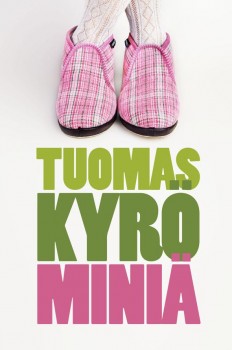 The twenty-third of April – Shakespeare’s birthday – is the international day of the book and the rose. The tradition derives, however, not from England but from Barcelona, where the tradition was for men to give women roses while women gave men books.
The twenty-third of April – Shakespeare’s birthday – is the international day of the book and the rose. The tradition derives, however, not from England but from Barcelona, where the tradition was for men to give women roses while women gave men books.
This year Finnish booksellers decided to celebrate the occasion by publishing a new novel which was given for free to all customers who made a purchase worth €10. This was the only way to get hold of a copy; the print run was 3,000 copies.
The chosen work was a new novel by Tuomas Kyrö, entitled Miniä (‘Daughter-in-law’). The narrator is the daughter-in-law of the main character of Kyrö’s two popular novels, Mielensäpahoittaja (‘Taking offence’) and Mielensäpahoittaja ja ruskeakastike (‘Taking offence: the brown sauce’). The grumpy old man from the country comes to stay with his son and his daughter-in-law in the capital – which inevitably results in practical (and mainly comical) discordance of various sorts.
Solzhenitsyn and Silberfeldt: Sofi Oksanen publishes a best-seller
25 April 2012 | In the news
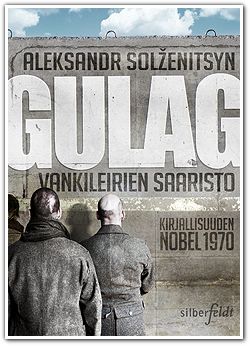
Nobel Prize 1970: Aleksandr Solzhenitsyn
After falling out with her original publisher, WSOY, in 2010, author Sofi Oksanen – whose third novel, Puhdistus (Purge, 2008), has become an international best-seller – has founded a new publishing company, Silberfeldt, in 2011, with the aim of publishing paperback editions of her own books. Its first release was a paperback version of Oksanen’s second novel, Baby Jane.
Oksanen’s new novel, Kun kyyhkyset katosivat (‘When the pigeons disappeared’), again set in Estonia, will appear this autumn, published by Like (a company owned by Finnish publishing giant Otava).
However, in April Silberfeldt published a new, one-volume edition of the autobiographical novel The Gulag Archipelago by the Nobel Prize-winning author Alexandr Solzhenitsyn. This massive book was first published in the West in 1973, in the Soviet Union in 1989.
A Finnish translation was published between 1974 and 1978. Back in those days of Cold War self-censorship, Finnish publishers felt unable to take up the controversial book, and the first volume was eventually printed in Sweden. The work, finally published in three volumes, has long since been unavailable.
This time the 3,000 new copies of Solzhenitsyn’s tome sold out in a few days; a second printing is coming up soon. Oksanen regards the work as a classic that should be available to Finnish readers.
What Finland read in March
13 April 2012 | In the news
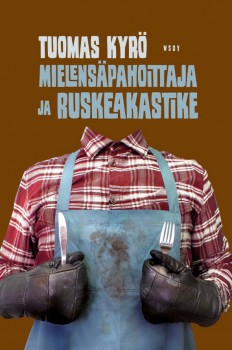
Tuomas Kyrö: ‘Taking offense’, part two
The top of the March list of best-selling fiction titles in Finland, compiled by the Finnish Booksellers’ Association, was Katja Kettu’s love story set in 1940s Finland at war, Kätilö (‘The midwife’, WSOY; see our feature).
Tuomas Kyrö (born 1974) featured twice on the list: Mielensäpahoittaja (‘Taking offense’, WSOY, 2010) was number two and the newly-published sequel, Mielensäpahoittaja ja ruskeakastike (‘Taking offense: the brown sauce’, 2012) had shot up to sixth place.
The title is actually a noun: ‘He who takes offence’: this person is an 80-something man who lives in the countryside and opposes most of what a contemporary lifestyle has to offer.
In the sequel, as his wife has to stay in a nursing home, ‘He who takes offence’ decides to learn how to cook for himself. He dismisses the ‘no-good’ girl who bring him food dailysent by a local agency. A firm believer in the potato, this no-nonsense character continues to fascinate lots of readers.
Rosa Liksom’s Finlandia Prize -winning novel set in the Soviet Union in the 1980s, Hytti nro 6 (‘Compartment number 6’, WSOY) occupied fourth place, a new novel about family life by Eve Hietamies, Tarhapäivä (‘Kindergarten day’, Otava) was number three.
The non-fiction list was topped by a new cookbook by Sikke Sumari, Sikke – ruokaa rakkaudella Toskanassa (‘Sikke – food with love in Tuscany’, Paasilinna). As books about birds featured on the list, one might assume spring is on the way, at last.
Best theatre, best play
16 March 2012 | In the news
On 11 March Finland’s theatre organisations gave their awards to last year’s best theatres and theatre-makers. Theatre of the Year was the Finnish National Theatre: according to the jury, it has both ‘opened all its doors, from cellar to attic’ and also left the building to make theatre and offered space for initiative. Audience figures have risen by more than 50,000, and the theatre’s repertoire has ‘cut keenly into the life and reality of contemporary audiences and the key national questions behind them without becoming bogged down in familiar stereotypes.’
The Finnish Dramatists’ Union awarded its Lea Prize for the Playtext of the Year, worth €5,000, to Pirkko Saisio’s HOMO! (This is Saisio’s fourth Lea Prize since 1986.) HOMO! is currently running, in a musical, or rather, operatic form in the National Theatre, in a production directed by the playwright herself; the composer is Jussi Tuurna.
In art as elsewhere, it is worth thinking about things from new angles – a few years back, for example, the National hardly did any musical theatre at all. (However, the company of actors in no way hinder the staging of musical theatre: under Tuurna’s direction, the entire cast burst into spectacular flower, alone and in chorus.) Besides, musical theatre was thought to be the province of the Helsinki City Theatre, where imported commercial musicals (Cats, Les Miserables, Mary Poppins etc) have lately represented a considerable part of the theatre’s income. On this production line, however, there are few chances for writers, composers and other theatremakers to develop a specifically Finnish musical theatre.
The Finnish National Theatre’s most recent success, Kristian Smeds’s Mr Vertigo also used original music, produced by young jazz musicians, which was on exactly the same wavelength as the text and its interpretation.
Beautiful books
9 March 2012 | In the news
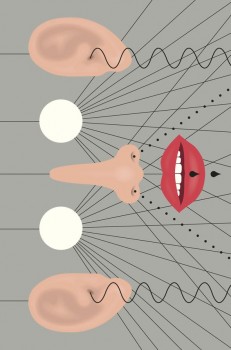
Design: Markus Pyörälä. The cover of Runojä (‘Poemms’) by Harry Salmenniemi
The Finnish Book Art Committee chooses the most beautiful books of the year from various categories of publications, and awards the prize of the Most Beautiful Book of the Year.
Graphic design, typography, cover and binding are all taken into consideration. Honorary diplomas are awarded to the designers, publishers, printers and other production units of the prize-winning books.
The Finnish Fair Foundation makes an annual grant to the Finnish Book Art Committee, which works in cooperation with the National Library of Finland. Representatives from various fields participate in the work of the juries. The prizes has been awarded since 1947.
This year the Most Beautiful Book of the Year was a collection of poetry by Harry Salmenniemi, Runojä (Runoja, ‘Poems’, deliberately misspelt in the title – ‘Poemms’?). The graphic designer is Markus Pyörälä, the publisher, Otava.
The jury commented: ‘Just as in the poetry itself, all the senses are engaged on the cover. The typography, so instrumental to prose poetry, provides structure and surprises…. All traditional beauty is there too: the tender touch of the paper, the snappy binding and the skillfully chosen fonts. Gold on the cover, overall, platinum.’
Henriikka Tavi wins the Dancing Bear Poetry Prize
1 March 2012 | In the news
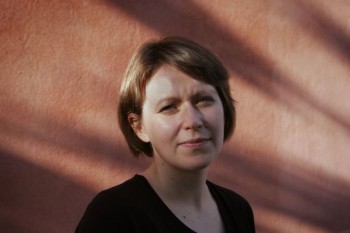
Henriikka Tavi. Photo: Heini Lehväslaiho
The Dancing Bear Poetry Prize, worth €3,500, is awarded annually by the Finnish Broadcasting Company to a book of poetry published the previous year. The prize has been awarded since 1994.
This year’s winner – announced on 27 February – was Henriikka Tavi for her new collection, Toivo (‘Hope’, Teos; see the selection of her poems, translated by David Hackston, we published in December, as well as the introduction by Mervi Kantokorpi).
According to the jury, Tavi’s Toivo, reflecting and contemplating sorrow and loss with its childlike imagery of lullabies and butterflies, creates a feeling of togetherness we all need.
The winner was selected by a jury of two journalists, Tarleena Sammalkorpi and Marit Lindqvist and the poet Ilpo Tiihonen. The other shortlisted poets were Kristian Blomberg, Suvi Valli, Markku Into, Harry Salmenniemi and Wava Stürmer.
In addition to the Dancing Bear Poetry Prize, the Finnish Broadcasting Company also awards a prize for the best poetry translation; this year it went to poet Caj Westerberg for his excellent poetry translations from the past two decades of the Swedish poet Tomas Tranströmer.
The novel that won: the Runeberg Prize 2012
9 February 2012 | In the news
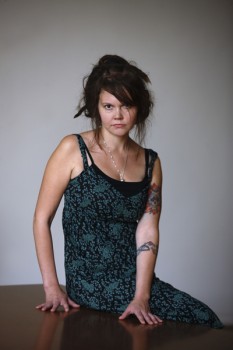
Katja Kettu. Photo: WSOY
The Runeberg Prize for fiction, awarded this year for the twenty-sixth time, went to Katja Kettu for her third novel, Kätilö (‘The midwife’, WSOY).
Kettu (born 1978) is a writer and director of animated films. The prize, worth €10,000, was awarded on 5 February – the birthday of the poet J.L Runeberg (1804–1877) – in the southern Finnish city of Porvoo.
The jury – representing the prize’s founders, the Uusimaa newspaper, the city of Porvoo, both the Finnish and Finland-Swedish writers’ associations and the Finnish Critics’ Association – chose the winner from a shortlist of eight books. The jury was particularly impressed by the rich language of Kettu’s novel, set in the Lapp War of 1944–45, and the colourful portrayal of the characters.
The other seven finalists were a collection of essays and poems, Magnetmemoarerna, by Ralf Andtbacka (‘Magnet memoirs’, Ellips), the novel Tusenblad, en kvinna som snubblar (‘Millefeuille, the woman who stumbles’, Schildts), the novel Gisellen kuolema (‘Giselle’s death’, Robustos) by Siiri Eloranta, two collections of poems, Aallonmurtaja (‘The breakwater’, Otava) by Pauliina Haasjoki and De bronsblå solarna (‘The bronze-blue suns’, Söderströms) by Kurt Högnäs, a collection of short stories by Joni Pyysalo, entitled Ja muita novelleja (‘And other stories’, WSOY) and the novel Paljain käsin (‘With bare hands’, Gummerus) by Essi Tammimaa.
A Finnish comics award
2 February 2012 | In the news
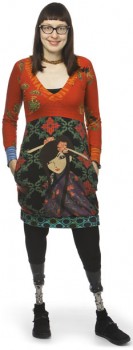
Kaisa Leka
Suomen sarjakuvaseura (The Finnish Comics Society) has awarded its Puupäähattu Award 2012 to the graphic artist and illustrator Kaisa Leka.
The prize is not money but a honorary hat, and is named after a classic Finnish cartoon character, Pekka Puupää (‘Pete Blockhead’), created by Ola Fogelberg and his daughter Toto. The Puupää comic books were published between 1925 and 1975, and some of the stories were made into film.
Leka describes herself as a mouse named Kaisa. Both of her legs have been replaced with steel prostheses, and she has featured disability in her comics book, for example in I Am Not These Feet.
Artificial limbs haven’t stopped her from cycling, for example, from Finland to Nice in France; she has described this tour in her book entitled Tour d’Europe.
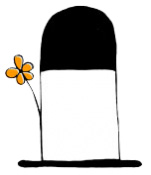
The award: Puupäähattu (‘Blockhead hat’)
(See a video of Kaisa cycling, by Lina Jelanski.)

